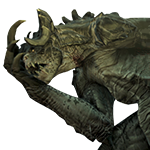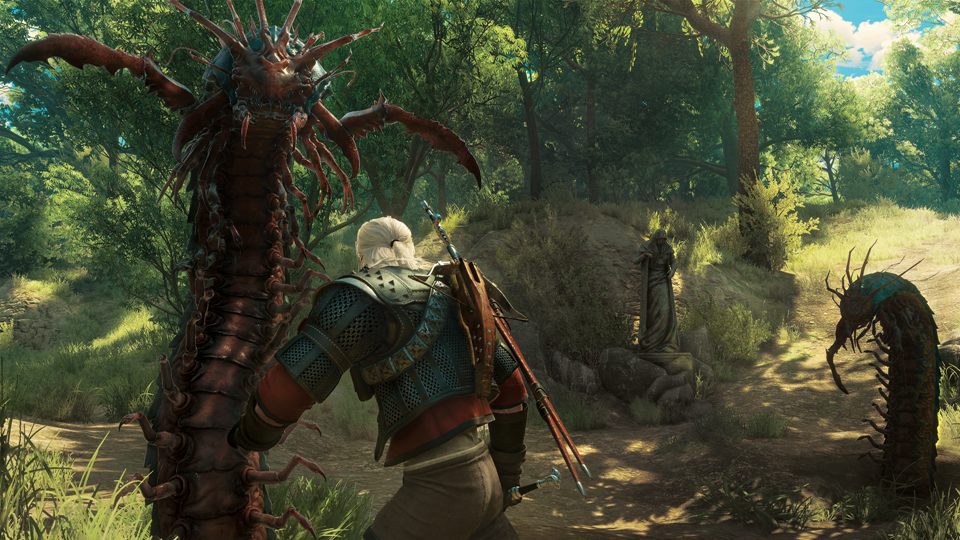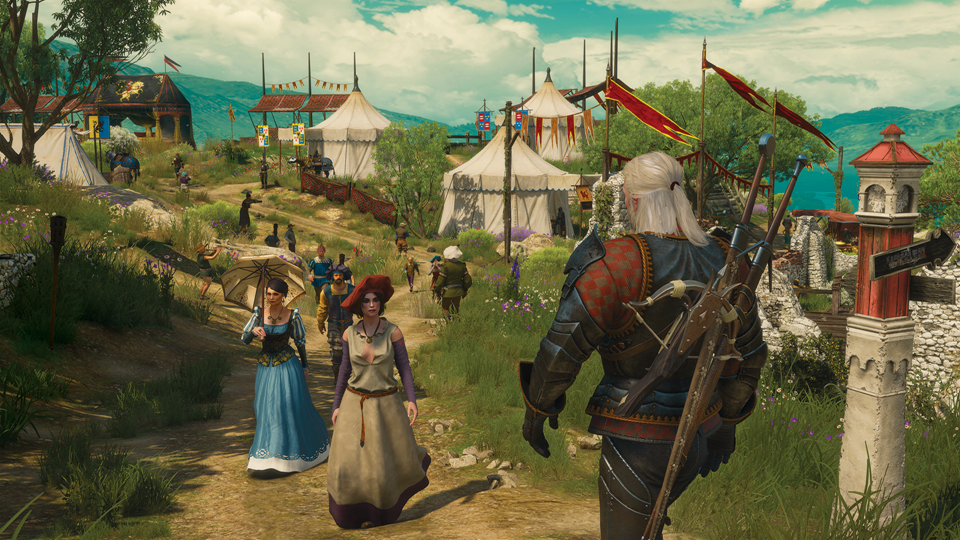The Witcher 3: Blood & Wine – an evolution of the “peasant misery simulator”
CD Projekt’s Patrick Mills on Geralt’s new adventures in a war-free land and telling stories through obscure quests.
“Don’t ever not tell a joke because it’s too obscure. The more obscure it is, the fewer people that can get the joke the funnier it is to those people. I think the same thing is true of quests, and events, and those little Easter eggs that happen.”
After
finishing up a three hour hands-on with Blood & Wine, CD Projekt’s final Expansion Pack for The Witcher 3, I’m ushered into a smaller room in the studio’s slick visitor’s area to chat to one of the developers about the expansion and reflections on The Witcher 3 in general.
A veteran of much-loved RPG studio Obsidian Entertainment, Patrick Mills landed at CD Projekt, another RPG behemoth, in 2013 as a quest designer. In our chat, we talk about the development of Blood & Wine, the philosophy of good sidequest design, and excitement for the future of the developer of this, one of the finest games of the generation so far.
VG247: Having just played for a few hours, I have to say that, wow, this world feels quite different to the ones we know from the main game. From the internal perspective of quest design and narrative, how do you feel about what you’re offering in Blood and Wine?
Patrick Mills: Well, basically the first thing I think of is playing through the original game. I’ve been working on this for a while, and I actually got to go back to the original game briefly recently. So I boot it up, I load in, and I’m in Velen… and, well, it’s just this peasant misery simulator… and I’m just like, oh god, this is so dark, so depressing, so sad. I was so happy when I got back to Beauclair in Blood and Wine. Of course there’s bad stuff that happens there, it’s still a Witcher game, and obviously there needs to be stuff for Geralt to solve – problems. But it felt nice to get back to this place. People are pretty happy, and thanks to that we get to present a different take on things.
Another side of how I feel is structural – in Witcher 3, we have all those points of interest, all those little question marks on the map. I think that we didn’t really feel that we had connected those properly to the world as well as we could have… so, with this one, and a little bit with Hearts of Stone… but more with this one, since it’s a new world, we were able to tie those in to the quests and build things out of them – build the world in a more organic way.
I don’t think the points of interest that we did in The Witcher 3 were bad, but I definitely think that the ones we’ve done now are better. Our quests tie into the world better in that way. In general, we were able to fix problems that we saw in The Witcher 3; we could come at them and say “hey, we’ve figured this out now, we know what we’re doing. We can make this even better.
VG247: From a development standpoint, how does it feel to work on something that’s a little more iterative, rather than working alongside a developing engine? Is that refreshing?
Definitely, yes – and at least on the quest team, I’ve played our stuff, and I’ve seen how people are working through things, and we’ve achieved a level of efficiency with our tools that I think not everybody had with The Witcher 3.
When we were developing that you’d sometimes make something and then need somebody else to help with a particular element of it – but at this point we’ve had so much experience that everybody can be the master of their own domain and build these quests out fully – able to say, hey, this is my vision, and I’m really going to fully commit to this vision. I think that’s been great, it’s been really nice to do.
There’s pros and cons to working on an expansion pack, but one of the biggest pros is that you go in and you already know what you’re doing. You’re at the top of your game. There’s no questions of ‘oh, how do I do this’, or ‘I need to go and ask the engine team for support’ – I know what I’m capable of and I know well what I can do in this toolset. It’s fun. It’s nice.
VG247: It’s obvious from today that you guys have had a lot of fun working on such a different environment tonally – how long have you been at this, considering its size?
Well, Hearts of Stone was developed on a much shorter timetable, and we could get away with that because it was taking place in the world that we already had. I couldn’t tell you precisely how long that was, but it was on an order of months. We’ve been working on this now… gosh, how long have we been working on this now?
PR: Hmm. It feels long. Really long. [laughs]
Yeah. It’s much longer – I would say probably twice as long, easily. I’ll be honest, they told us we have a vacation coming up and I’m like “What, really?!” [laughs] I have no head for calendar dates or anything – it all just blends together. But, y’know, we’ve been working on it for a long while. It’s much more time consuming, but there is a lot in this. There’s lots and lots of quests. That’s something that — on Hearts of Stone it was mostly the core story of the expansion. With this one we’ve got that core story, and it’s actually a little bit longer than the Hearts of Stone core story, but then we also have tremendous amounts of side content.
That’s actually the sort of side I enjoy a little bit more, because we can tell our own stories and tell smaller, self-contained stories, and there are lots of them. If you just walk around that city… the other day I just loaded it up myself to test something. Normally we just test on our little sections, but I loaded up the whole thing that time, and I’m walking through it and there’s just… a quest, and a quest, and a quest, and a quest. I see an event happening, and I know that leads to a quest, and this thing over here ties into a quest… there’s lots going on here.
It’s very nice with this expansion – by having a whole new world, we really got to design that structure from the beginning all over again.
VG247: In terms of what you and your team do, I think one of the most impressive things is how a piece of side content can stand out so much. What’s the philosophy behind side quests, and how do you not get tempted to make such strong quests more compulsory?
“It’s just this peasant misery simulator… and I’m just like, oh god, this is so dark, so depressing, so sad. I was so happy when I got back to Beauclair in Blood and Wine. “
For me, and I can only speak for myself here, as all of our quest designers have their own process – my process is to find an idea. It can be a gameplay feature, a funny scene, a joke, anything like that – find that, build something around that, and then don’t stop there – go ahead and find the core themes. I ask, ‘OK, what’s interesting here’ beyond that little nugget at the core of it. Find that, accentuate it, then use the story to fully bring that out.
As for certain quests becoming harder to miss or part of the main game, there’s a push and pull on that. You will have people say ‘Oh, we need to make sure that this gets seen by absolutely every player’. Then you have people like me on the opposite side of that argument, pushing back.
Thankfully we do have the ability to push back on those things. My favourite piece of this expansion, not everybody’s going to see – there isn’t that much signposting to push people towards it. I’m of the philosophy that the fewer people that experience a thing, the more ownership they feel over it. So when you see this cool thing that your friends maybe didn’t see, you get to tell them ‘Oh, I saw this thing!’
Even in the era of YouTube, you put that YouTube video up — hey, I found this neat thing. And you found it! It’s yours! Do you know the TV show Mystery Science Theatre 2000? They said a very smart thing about comedy – they said “Don’t ever not tell a joke because it’s too obscure.” The more obscure it is, the fewer people that can get the joke the funnier it is to those people. I think the same thing is true of quests, and events, and those little Easter eggs that happen, and I very firmly believe in that, so I always push to have things in there for players to find and really own.
VG247: Do you think that with the reaction to things like the Bloody Baron quest, the obvious example, you’ve reached a new point in video game storytelling?
I think that we’ve just started to get good at it, and we have a long way to go. There’s been some very interesting stuff in the indie space, and I unfortunately haven’t got to see all that much of it, since it exploded when we were at our busiest on this game. But at least in Triple-A gaming we’ve just started to get… we’ve pulled our way up, and we’re starting to tell some really interesting stories and have some really interesting interactions and things. I’m really looking forward to what we can do in the future. I think this expansion moves our storytelling forwards too, in interesting ways – but that’s for our audience to judge.
I’m really excited to see where things go from here, but I’m really excited for the future because I think we’ve just started to get good at all this.
VG247: Okay, so I know we can’t talk about what you’ll be doing next… [PR nods along enthusiastically with this point] but I want to at least touch on it. So, you’re going to be heading to a very different world to the Witcher with Cyberpunk. Is there anything like that which stands out as particularly exciting or challenging to you?
That’s a good question! Er… what I will say… very generally… [laughs] is that working with different universes, different styles of storytelling, different licenses… it brings different challenges. It will be very interesting to see how we adapt to that. The stories we’ve been telling are pretty specific but also a lot of those stories are universal; we can still tell those in different spaces.







































